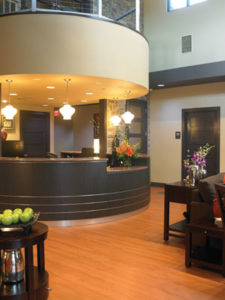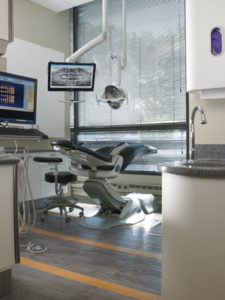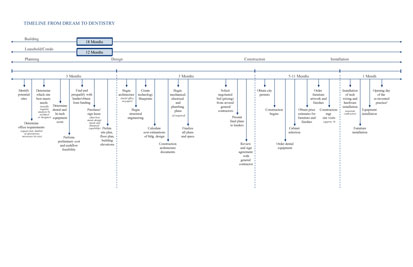In designing and building a new office, the ultimate mark of success is revealed a year after completion with the owners’ comment that they would not change any element of the design.
Every Journey Starts With the First Step, "Have you been thinking about a new office"…for years? What is keeping you from moving forward with the desire to improve your facility and practice? Many of us will cite circumstances that are seemingly beyond our control (insert your favorite reason here), but after thousands of conversations with doctors over many years, I would suggest two reasons for inaction: fear and inertia.
Fear is a four letter word.
There is fear of the unknown in that you don’t know where to start, how to proceed, and that you will lose control. We are in total control (most of the time) in our office, but when we embark on designing and building a new office, we don’t even know what we don’t know. Now, that is frightening.
Losing control of the cost of the project is a big fear because it leads to an even bigger fear: financial failure. What if we could eliminate this fear and risk to zero?
Well, now you are talking!
 Fear is an emotion, and an emotion should not drive a financial decision; numerical facts should drive your decision to build a new office. EXACTLY, what will the project cost? Incidentally, Pelton & Crane is able to assist with this calculation (project cost, cash flow analysis, and risk assessment) with their new project management tool called inView and their analysis is spot on.
Fear is an emotion, and an emotion should not drive a financial decision; numerical facts should drive your decision to build a new office. EXACTLY, what will the project cost? Incidentally, Pelton & Crane is able to assist with this calculation (project cost, cash flow analysis, and risk assessment) with their new project management tool called inView and their analysis is spot on.
Your project cost can be calculated in the following manner. First, after understanding your vision of your dream office, the architect should make an estimate of building cost. Second, that estimate must be used by an accountant to calculate the impact on your cash flow to determine if you can fund the project and still meet all of your current financial obligations.
Third, the calculated increase in cash flow should be divided by your current production to assess the risk in undertaking the project. For example, if the cash flow analysis results in a production increase requirement of $5,000/month and you are currently collecting $50,000/month, then you would have a 10% production increase requirement. This value of 10%, by itself, is meaningless. But when compared to the thousands of projects with which I have been involved over the past decades, we found that projects that required less than a 20% increase in production had virtually no risk of failure, i.e., being able to cash flow the project during their (critical) first year in the new office. However, this metric applies only to those new offices that employ the principles of dental office design described in my book, A Guide to Designing the Elegant Dental or Medical Office: The Largest Marketing Tool of Your Career.
If the production increase requirement is greater than 20%, your risk increases. Now the possibility of failure is real. So, you either scale back the project and repeat the calculations, or you attempt to increase your current production and thereby decrease the quotient which is the production increase required.
Do You Have Tired Blood?
The second reason I cited for not moving forward with a new office is inertia. We have so many professional and personal demands on our time that it seems we never get to anything that is not essential.
And therein is the answer.
 IF YOU EVER WANT TO HAVE A NEW OFFICE, IT MUST BE TOP PRIORITY.
IF YOU EVER WANT TO HAVE A NEW OFFICE, IT MUST BE TOP PRIORITY.
It is hard to have a sense of urgency if you don’t know what you are missing. If you have always been swimming upstream, you have no idea how easy it is to swim with the current. To put this metaphor in tangible terms, doctors who incorporate the principles of dental office design into their new facilities actually work 2.5 hours less each week in direct patient care going from 31 hours/week to 28.5 hours/week, and their production increases by an average of 38%. These results have been achieved in over 3,000 offices across the country spanning two and a half decades.
Time dulls our memories of the effort we expended to obtain our dental degree. Perhaps refreshing our memories would motivate us to capitalize on our education with an office that 1) makes our daily efforts easier and less stressful, and 2) drives our production by physically communicating the quality of care we are providing to our patients. We, and our practices, will be successful when the office environment is consistent and congruent with the care we are proposing to our patients.
Go West, Young Man
So, what is the first step? How do you decide whether to build from the ground up, finish out a lease space, buy a condominium, or remodel?
First, determine the number of operatories you will need in the new office. This should be carefully discussed with your Henry Schein Equipment Sales Specialist and/ or practice management consultant, but I will offer the observation that doctors characteristically and almost universally underestimate the number of operatories needed. Remember that the incremental cost of an additional operatory is dwarfed by the opportunity cost of lost revenue in an office that has an insufficient number of operatories. Pelton & Crane’s inView program includes a financial calculator that is used to compare the bottom line impact of choosing to add an additional operatory.
Second, determine the size of the office (space) and the size of the lot needed to support the practice. The metric I use is that we need approximately 500 usable square feet of office space per operatory, so a 5 operatory office would need about 2,500 useable square feet (space inside the walls). Next, the size of the lot needed is generally six times the size of the office, so 6 X 2,500 square feet= 15,000 sq. ft.
Third, define the search area for the new location. As a general rule, you can move up to seven miles from your previous location and not lose patients as long as you don’t cross any psychological boundaries such as bridges going from one side of town (good) to another (bad). Also, you want to be in a class A building if leasing or purchasing a condo; commercial real estate ranks properties as class A, B, or C with C being a warehouse. Finally, you want to be in an area or neighborhood that is consistent with the level of care you are providing and the type of patient you are attempting to attract.
 Fourth, ask your Henry Schein Equipment Sales Specialist (ESS) to help find a good commercial real estate person and ask them to find all of the opportunities that fit the above criteria. Then review the results with your ESS and select the top three candidates based on the above criteria and your knowledge of the local area.
Fourth, ask your Henry Schein Equipment Sales Specialist (ESS) to help find a good commercial real estate person and ask them to find all of the opportunities that fit the above criteria. Then review the results with your ESS and select the top three candidates based on the above criteria and your knowledge of the local area.
Fifth, with your architect and ESS, determine the cost of the project for each of the three selected options. Then using the financial calculator available in inView—calculate the impact on the practice’s cash flow and determine the level of risk associated with each option.
Sixth, select the single best option that will yield the most optimal floor plan result (The optimal floor plan will incorporate the tangible principles of dental office design. These are enumerated in my book.) and financial result, that is, the total production increase requirement is less than 20%.
Now you have the beginnings of a great office, one that can generate substantially higher revenues and produce less physical stress. But it is only the beginning because now you must engage an architect to design the office and to control cost, build the office on paper. There are literally thousands of decision points during the construction process and they must have answers or the contractor will make a decision on the spot that will affect the price of the project. Cost over runs occur because many of the construction decision points were not addressed in the architectural drawings, so insist that your architectural drawings are complete with all necessary schedules and plans.
Getting There From Here
At this point, we are feeling pretty good. We have selected a location, we know the cost of the project, the impact on cash flow, the financial risk associated with the project, and we have a floor plan. We know we need an architectural plan that builds the office on paper to control costs, and a good general contractor who understands how to build dental offices. Note: Here is another decision in which your Henry Schein ESS can be of great assistance in securing a knowledgeable contractor. Dental offices are very different from other buildings in that they are much more complicated with all of the electrical, mechanical, medical gases, plumbing, and technology issues that must be correctly addressed. Employing an uninformed contractor will delay the project’s completion, yield a poorer result, and will increase construction costs.
There are still many issues to address. I have put them on a timeline rather than attempt to chronicle them. If you feel somewhat overwhelmed, that is natural and expected. I suggest that my clients create an inView account. Pelton & Crane has compiled years of office design expertise into a project management portal to help your project stay on task and on budget.
inView includes more than a robust financial analysis, it serves as a guide throughout each step of the dental office design process. Members of your project team can collaborate, track the progress of your project and share documents in one secure location. THIS IS CRITICAL BECAUSE IT IS IMPORTANT THAT EVERYONE KNOWS WHAT EVERYONE ELSE IS DOING in a project that has hundreds of moving parts.
You can register for a complimentary inView account at: www.yourfutureinview.com. Thousands of doctors have successfully completed beautiful and functional offices—you can too. The key is to surround yourself with an experienced team and take advantage of the tools that will help you succeed.
In designing and building a new office, the ultimate mark of success is revealed a year after completion with the owners’ comment that they would not change any element of the design. When you stand in your new office and make this statement, you will have the office of your dreams.
This article was originally published in Sidekick Magazine.
About the Author
Dr. Mark Tholen graduated from the University of Texas Dental School and U.T. Graduate School of Business with an MBA. He served in the U.S. Air Force and was engaged in practice before turning his attention to industry. He is the former CEO of T.H.E. Design, a dental and medical office design firm and author of the book, A Guide to Designing the Elegant Dental Office…The Largest Marketing Tool of Your Career. He can be reached at marktholen2000@yahoo.com or 972-365-6151. Dr. Tholen lectures throughout the US and Canada frequently and is engaged in the active design of dental offices with Fazio Architects of Austin, Texas.
